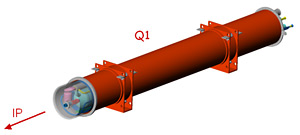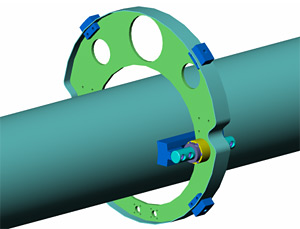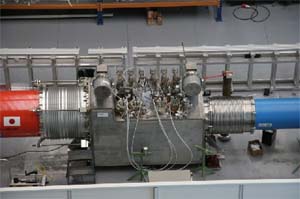Fermilab Update on Inner Triplet Magnets at LHC
 |
| Q1 Quadrupole Magnet – CERN and Fermilab are working to identify repairs to the structures that hold the cold mass (blue) in place within the cryostat (orange) in each magnet of the triplet on either side of the LHC's four interaction points. The Q1 magnet of each triplet is the magnet closest to the interaction point (IP). |
 |
| Longitudinal force during a pressure test broke the G-11 support structure (green) securing the cold mass (blue) inside the magnet cryostat (not shown). |
 |
| A distribution feed box, or DFBX, center, in an above-ground test assembly at CERN in April 2005. The status of the DFBX that provides cryogenic fluids and electrical power for the inner triplet magnets at Interaction Point 5 is being investigated. |
On Tuesday, March 27, a Fermilab-built quadrupole magnet, one of an “inner triplet” of three focusing magnets, failed a high-pressure test at Point 5 in the tunnel of the LHC accelerator at CERN. Since Tuesday, teams at CERN and Fermilab have worked closely together to address the problem and have identified the cause of the failure. Now they are at work on a solution.
The asymmetric force generated by the pressure of the test broke the supports in magnet Q1 that hold the magnet’s cold mass inside the cryostat, which also resulted in damage to the electrical connections. The status of the Q1 cold mass itself is still being determined, as is the status of the other two magnets in the triplet, Q2 and Q3. Also under investigation is the status of a distribution feed box, or DFBX, designed to provide cryogenic fluids and electrical power for the inner triplet magnets.
The magnet supports are made of a material called G-11, a glass cloth-epoxy laminate. The specifications for the magnet designate 20 atmospheres as the design pressure criterion and 25 atmospheres as the acceptance test criterion. However, computer-aided engineering calculations completed independently by Fermilab and CERN on March 28 show that the G-11 support structure in the magnets was inadequate to withstand the associated longitudinal forces. CERN and Fermilab now know that this is an intrinsic design flaw that must be addressed in all triplet magnets assembled at Fermilab.
Review of engineering design documentation reveals that the longitudinal force generated by asymmetric loading was not included in the engineering design or identified as an issue in the four design reviews that were carried out.
The goal at CERN and Fermilab is now to redesign and repair the inner triplet magnets and, if necessary, the DFBX without affecting the LHC start-up schedule. Teams at CERN and Fermilab have identified potential repairs that could be carried out expeditiously without removing undamaged triplet magnets from the tunnel. All three of the pressure-tested triplet magnets at Point 5, plus the associated DFBX, will be removed from the tunnel for inspection and, if necessary, repair.
CERN will manage the redesign and repair effort and has scheduled a review for April 24-25 to validate the selected method. Fermilab will take part in the review.
Repair of the triplet magnets would begin after validation by the reviewers. The immediate goal is to have a repaired triplet in another sector of the accelerator ready to participate in a pressure test scheduled for June 1.
The effort between Fermilab and CERN is being closely coordinated. Fermilab personnel are on site at CERN. Fermilab physicists, engineers and technicians will continue to provide whatever assistance CERN requests, both at Fermilab and at CERN.
In addition to addressing the current problem, Fermilab has begun examining all aspects of US-supplied components to identify any other potential vulnerabilities.
Fermilab will appoint an external review committee to analyze how this problem occurred and determine root causes and lessons learned.
LHC Magnet Updates
|